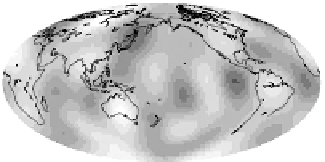Geoscience Reference
In-Depth Information
Figure 8.8.
Perturbations
in the quality factor,
Q
,of
the upper mantle. Colour
version Plate 13. (From
Gung and Romanowicz
(2004).)
140 km
200 km
250 km
340 km
450 km
600 km
−
50
0
50
δ
ln(1/Q) (%)
anomaly running north-south beneath North America and another extending
from the Mediterranean to Southeast Asia. These anomalies are interpreted as
the subducted Farallon and Tethys slabs (Chapter 3). Figure 8.6(e) (Plate 12), a
cross section from the Aegean through Asia to Japan, suggests that clues to the
complex accretionary process that assembled the continent may be present in the
underlying mantle.
Figure 8.9 shows the locations of high-density subducted slabs in the mantle
for the present day and 56 Ma ago. The high-velocity anomalies around the Pacific
correlate with positions of lithosphere that has been subducted into the mantle
over the last 100 Ma or so. High velocities through Eurasia appear to mark the
location of the Tethys subduction. This indicates that the upper mantle and the
lower mantle cannot be two totally separate systems as some geochemical mod-
els imply. However, the upper and lower mantle are distinct: the fast region
beneath South America does not extend below
1400 km. Had the Farallon plate
descended through the lower mantle at the same rate as it did through the upper
mantle, there would be a high-velocity zone extending all the way to the CMB.
∼





































































































